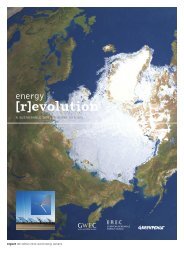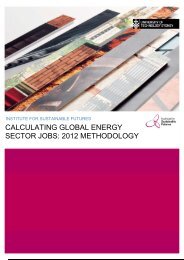download the mexico energy revolution scenario
download the mexico energy revolution scenario
download the mexico energy revolution scenario
Create successful ePaper yourself
Turn your PDF publications into a flip-book with our unique Google optimized e-Paper software.
image THE WIND TURBINES ARE GOING<br />
TO BE USED FOR THE CONSTRUCTION OF<br />
AN OFFSHORE WINDFARM AT<br />
MIDDELGRUNDEN WHICH IS CLOSE<br />
TO COPENHAGEN, DENMARK.<br />
© LANGROCK/ZENIT/GP<br />
In <strong>the</strong> future we need to change <strong>the</strong> grid network so that it does not<br />
rely on large conventional power plants but instead on clean <strong>energy</strong><br />
from a range of renewable sources. These will typically be smaller<br />
scale power generators distributed throughout <strong>the</strong> grid. A localised<br />
distribution network is more efficient and avoids <strong>energy</strong> losses<br />
during long distance transmission. There will also be some<br />
concentrated supply from large renewable power plants. Examples<br />
of <strong>the</strong>se large generators of <strong>the</strong> future are <strong>the</strong> massive wind farms<br />
already being built in Europe’s North Sea and <strong>the</strong> plan for large<br />
areas of concentrating solar mirrors to generate <strong>energy</strong> in Sou<strong>the</strong>rn<br />
Europe or Nor<strong>the</strong>rn Africa.<br />
The challenge ahead is to integrate new generation sources and at<br />
<strong>the</strong> same time phase out most of <strong>the</strong> large scale conventional power<br />
plants, while still keeping <strong>the</strong> lights on. This will need novel types of<br />
grids and an innovative power system architecture involving both<br />
new technologies and new ways of managing <strong>the</strong> network to ensure<br />
a balance between fluctuations in <strong>energy</strong> demand and supply.<br />
The key elements of this new power system architecture are micro grids,<br />
smart grids and an efficient large scale super grid. The three types of<br />
system will support and interconnect with each o<strong>the</strong>r (see Figure 4.3).<br />
A major role in <strong>the</strong> construction and operation of this new system<br />
architecture will be played by <strong>the</strong> IT sector. Because a smart grid<br />
has power supplied from a diverse range of sources and locations it<br />
relies on <strong>the</strong> ga<strong>the</strong>ring and analysis of a large quantity of data. This<br />
requires software, hardware and networks that are capable of<br />
delivering data quickly, and responding to <strong>the</strong> information that <strong>the</strong>y<br />
contain. Providing <strong>energy</strong> users with real time data about <strong>the</strong>ir<br />
<strong>energy</strong> consumption patterns and <strong>the</strong> appliances in <strong>the</strong>ir buildings,<br />
for example, helps <strong>the</strong>m to improve <strong>the</strong>ir <strong>energy</strong> efficiency, and will<br />
allow appliances to be used at a time when a local renewable<br />
supply is plentiful, for example when <strong>the</strong> wind is blowing.<br />
There are numerous IT companies offering products and services to<br />
manage and monitor <strong>energy</strong>. These include IBM, Fujitsu, Google,<br />
Microsoft and Cisco. These and o<strong>the</strong>r giants of <strong>the</strong><br />
telecommunications and technology sector have <strong>the</strong> power to make<br />
<strong>the</strong> grid smarter, and to move us faster towards a clean <strong>energy</strong><br />
future. Greenpeace has initiated <strong>the</strong> ‘Cool IT’ campaign to put<br />
pressure on <strong>the</strong> IT sector to make such technologies a reality.<br />
hybrid systems<br />
The developed world has extensive electricity grids supplying power<br />
to nearly 100% of <strong>the</strong> population. In parts of <strong>the</strong> developing world,<br />
however, many rural areas get by with unreliable grids or polluting<br />
electricity, for example from stand-alone diesel generators. This is<br />
also very expensive for small communities.<br />
The electrification of rural areas that currently have no access to<br />
any power system cannot go ahead as it has in <strong>the</strong> past. A standard<br />
approach in developed countries has been to extend <strong>the</strong> grid by<br />
installing high or medium voltage lines, new substations and a low<br />
voltage distribution grid. But when <strong>the</strong>re is low potential electricity<br />
demand, and long distances between <strong>the</strong> existing grid and rural<br />
areas, this method is often not economically feasible.<br />
Electrification based on renewable <strong>energy</strong> systems with a hybrid mix of<br />
sources is often <strong>the</strong> cheapest as well as <strong>the</strong> least polluting alternative.<br />
Hybrid systems connect renewable <strong>energy</strong> sources such as wind and<br />
solar power to a battery via a charge controller, which stores <strong>the</strong><br />
generated electricity and acts as <strong>the</strong> main power supply. Back-up supply<br />
typically comes from a fossil fuel, for example in a wind-battery-diesel or<br />
PV-battery-diesel system. Such decentralised hybrid systems are more<br />
reliable, consumers can be involved in <strong>the</strong>ir operation through innovative<br />
technologies and <strong>the</strong>y can make best use of local resources. They are<br />
also less dependent on large scale infrastructure and can be constructed<br />
and connected faster, especially in rural areas.<br />
Finance can often be an issue for relatively poor rural communities<br />
wanting to install such hybrid renewable systems. Greenpeace has<br />
<strong>the</strong>refore developed a model in which projects are bundled toge<strong>the</strong>r in<br />
order to make <strong>the</strong> financial package large enough to be eligible for<br />
international investment support. In <strong>the</strong> Pacific region, for example,<br />
power generation projects from a number of islands, an entire island<br />
state such as <strong>the</strong> Maldives or even several island states could be<br />
bundled into one project package. This would make it large enough<br />
for funding as an international project by OECD countries. Funding<br />
could come from a mixture of a feed-in tariff and a fund which<br />
covers <strong>the</strong> extra costs, as proposed in <strong>the</strong> “[R]enewables 24/7”<br />
report, and known as a Feed-in Tariff Support Mechanism. In terms<br />
of project planning, it is essential that <strong>the</strong> communities <strong>the</strong>mselves<br />
are directly involved in <strong>the</strong> process.<br />
4<br />
<strong>the</strong> <strong>energy</strong> [r]evolution | HYBRID SYSTEMS<br />
elements in <strong>the</strong> new power system architecture<br />
A hybrid system based on more than one generating source, for<br />
example solar and wind power, is a method of providing a secure<br />
supply in remote rural areas or islands, especially where <strong>the</strong>re is no<br />
grid-connected electricity. This is particularly appropriate in<br />
developing countries. In <strong>the</strong> future, several hybrid systems could be<br />
connected toge<strong>the</strong>r to form a micro grid in which <strong>the</strong> supply is<br />
managed using smart grid techniques.<br />
A smart grid is an electricity grid that connects decentralised<br />
renewable <strong>energy</strong> sources and cogeneration and distributes power<br />
highly efficiently. Advanced communication and control technologies<br />
such as smart electricity meters are used to deliver electricity more<br />
cost effectively, with lower greenhouse intensity and in response to<br />
consumer needs. Typically, small generators such as wind turbines, solar<br />
panels or fuels cells are combined with <strong>energy</strong> management to balance<br />
out <strong>the</strong> load of all <strong>the</strong> users on <strong>the</strong> system. Smart grids are a way to<br />
integrate massive amounts of renewable <strong>energy</strong> into <strong>the</strong> system and<br />
enable <strong>the</strong> decommissioning of older centralised power stations.<br />
A super grid is a large scale electricity grid network linking<br />
toge<strong>the</strong>r a number of countries, or connecting areas with a large<br />
supply of renewable electricity to an area with a large demand -<br />
ideally based on more efficient HVDC (High Voltage Direct<br />
Current) cables. An example of <strong>the</strong> former would be <strong>the</strong><br />
interconnection of all <strong>the</strong> large renewable based power plants in <strong>the</strong><br />
North Sea. An example of <strong>the</strong> latter would be a connection between<br />
Sou<strong>the</strong>rn Europe and Africa so that renewable <strong>energy</strong> could be<br />
exported from an area with a large renewable resource to urban<br />
centres where <strong>the</strong>re is high demand.<br />
41



![Energy [R]evolution - European Commission](https://img.yumpu.com/49109324/1/184x260/energy-revolution-european-commission.jpg?quality=85)


![5905 gp [eu rev]csfr4.qxd - Energy [R]evolution](https://img.yumpu.com/42305023/1/184x260/5905-gp-eu-revcsfr4qxd-energy-revolution.jpg?quality=85)


![5905 gp [eu rev]csfr4.qxd - Energy [R]evolution](https://img.yumpu.com/28729264/1/184x260/5905-gp-eu-revcsfr4qxd-energy-revolution.jpg?quality=85)